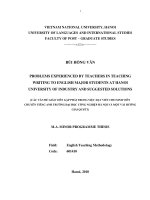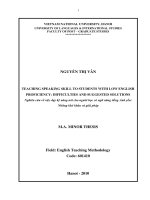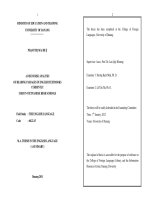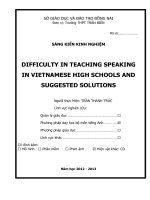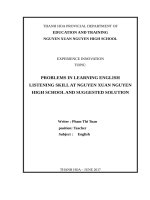skkn DIFFICULTY IN TEACHING SPEAKING IN VIETNAMESE HIGH SCHOOLS AND SUGGESTED SOLUTIONS
Bạn đang xem bản rút gọn của tài liệu. Xem và tải ngay bản đầy đủ của tài liệu tại đây (208.41 KB, 18 trang )
SỞ GIÁO DỤC VÀ ĐÀO TẠO ĐỒNG NAI
Đơn vị: Trường THPT TRẤN BIÊN
Mã số:.....................
SÁNG KIẾN KINH NGHIỆM
DIFFICULTY IN TEACHING SPEAKING
IN VIETNAMESE HIGH SCHOOLS AND
SUGGESTED SOLUTIONS
Người thực hiện: TRẦN THANH TRÚC
Lĩnh vực nghiên cứu:
Quản lý giáo dục
.................................................................
Phương pháp dạy học bộ môn tiếng Anh
Phương pháp giáo dục
Lĩnh vực khác
Có đính kèm:
Mô hình Phần mềm
.................
......................................................
........................................................................
Phim ảnh
Hiện vật khác: CD
Năm học 2012 - 2013
SƠ LƯỢC LÝ LỊCH KHOA HỌC
..............................................................
I. THÔNG TIN CHUNG VỀ CÁ NHÂN:
1.
2.
3.
4.
5.
6.
7.
Họ và tên: Trần Thanh Trúc
Ngày tháng năm sinh: 06 – 07 - 1985
Nam,nữ: Nữ
Địa chỉ: 14G, khu phố 6, phường Trung Dũng, Biên Hòa, Đồng Nai
Điện thoại: 0916772819
Chức vụ: Giáo viên
Đơn vị công tác: Trường THPT Trấn Biên – Biên Hòa – Đồng Nai.
II. TRÌNH ĐỘ ĐÀO TẠO:
•
•
•
Học vị ( hoặc trình độ chuyên môn, nghiệp vụ ) cao nhất: Thạc sĩ
Năm nhận bằng: 2011 do Curtin University cấp
-Chuyên ngành đào tạo: Ngôn ngữ học ứng dụng & phương pháp giảng dạy
tiếng Anh
III. KINH NGHIỆM KHOA HỌC:
Lĩnh vực chuyên môn có kinh nghiệm: giảng dạy tiếng Anh
Số năm công tác: 6 năm
Các sáng kiến kinh nghiệm đã có trong 6 năm gần đây:
Using Games to teach English in Vietnamese High School (2011-2012)
2
2
SỞ GD & ĐT ĐỒNG NAI
TRƯỜNG THPT TRẤN BIÊN
CỘNG HÒA XÃ HỘI CHỦ NGHĨA VIỆT NAM
Độc Lập - Tự Do - Hạnh Phúc
-------Biên hòa, ngày 27 tháng 05 năm 2013
PHIẾU NHẬN XÉT, ĐÁNH GIÁ SÁNG KIẾN KINH NGHIỆM
Năm học : 2012 – 2013
ĐỀ TÀI:
“DIFFICULTY IN TEACHING SPEAKING SKILLS IN VIETNAMESE
HIGH SCHOOLS AND SUGGESTED SOLUTIONS”
Họ và tên tác giả: Trần Thanh Trúc Đơn vị (tổ) Ngoại ngữ
Lĩnh vực:
Quản lý giáo dục
Phương pháp dạy học bộ môn: Tiếng Anh
Phương pháp giáo dục
Lĩnh vực khác………………
1.
Tính mới:
- Có giải pháp hoàn toàn mới
- Có giải Pháp cải tiến, đổi mới từ giải pháp đã có
2.
Hiệu quả
- Hoàn toàn mới và đã triển khai áp dụng trong toàn ngành có hiệu quả cao
- Có tính cải tiến hoặc đổi mới từ những giải pháp đã có và đã triển khai áp dụng
trong toàn ngành có hiệu quả cao
- Hoàn toàn mới và có áp dụng tại đơn vị có hiệu quả cao
- Có tính cải tiến hoặc đổi mới từ những giải pháp đã có và đã triển khai áp dụng
tại đơn vị đạt kết quả cao
3.
Khả năng áp dụng
- Cung cấp được các luận cứ khoa học cho việc họach định dường lối chính sách:
Tốt
Khá
Đạt
- Đưa các giải pháp khuyến nghị có khả năng ứng dụng thực tiễn dễ thực hiện và dễ
đi vào cuộc sống:
Tốt
Khá
Đạt
- Đã được ứng dụng trong thực tế đạt hiệu quả hoặc có khả năng áp dụng đạt hiệu quả
trong phạm vi rộng:
Tốt
Khá
Đạt
XÁC NHẬN CỦA TỔ
THỦ TRƯỞNG ĐƠN VỊ
CHUYÊN MÔN
Nguyễn Thị Thanh Hồng
3
3
Contents
4
4
DIFFICULTY IN TEACHING SPEAKING SKILLS IN
VIETNAMESE HIGH SCHOOLS AND SUGGESTED SOLUTIONS
I.
Introduction
In the late 1980s, Vietnamese government decided to carry out economic
reforms, commonly known as ‘Doi Moi’ (Renovation). The aims of Doi Moi were to
restructure the economy of Vietnam and to raise the living standards of the people.
From then on, people rushed to English language centers to get a certificate to the
world workforce. After a decade, in 1990s, English became a compulsory and
standard subject in every high school’s curriculum in Vietnam. A seven-year English
program was widely applied in almost secondary schools to supply Vietnamese
students with the knowledge of English to enter the global competitive workforce.
However at that time, English learning was emphasized on learning vocabulary and
grammar. Students become ‘dumb and deaf’ in English after graduating from High
Schools. It was not until 2003 that The Ministry of Education and Training
introduced the new series of textbooks with the first publication for grade 6. Until
now, a new seven-year English program has been applied with four skills: reading,
speaking, listening and writing. This new program aims to help students become
perfect learners with the ability to listen and speak English. Unluckily, when
applying this new series, teachers have faced a lot of difficulties, especially with
speaking skills. What are their difficulties in teaching English?
II.
Literature review
1. An overview on CLT.
As Nunan (1991) wrote,” success is measured in terms of the ability to carry
out a conversation in a target language”. Supporting this belief, Yu (2001:195)
quoted Li’s idea in 1984 in “In Defense of the Communicative Approach”. Li stated
5
5
that “language is communication & learning a language is learning how to
communicate”. Having the same idea with Li, Applegate (1975:271) says
“Knowledge of a second language should include more than just grammatical
competence”. If one says he knows a language, he has to know how to communicate
with others in that language. Knowing grammar & vocabulary is not enough.
Grammar & vocabulary are only means of communicating. The most importance
here is that students have to know how & when to say what to whom. Or as
Applegate (1975:271) says communication can only be effective when the student is
also sensitive to the social & cultural aspects of language use & how these differ
between his first & second language”. Accordingly, in an article Canale & Swain
(1980) gave the notion of communicative competence. In their points of view,
communicative competence is understood as “the underlying system of knowledge &
skills required for communication”. Canale (1983) states that a learner who is
competent in communication has to obtain four competences: grammatical
(linguistic) competence, sociolinguistics competence, discourse competence &
strategic competence.
Grammatical (linguistic) competence can be understood as the mastery of
language codes, which is the features & rules of the language such as word
formation, pronunciation, spelling & linguistic semantics. Canale (1983) states that it
is related to the knowledge & skills that are used to express accurately the literal
meaning of utterances.
Acquiring grammatical competences does not make a learner be able to
communicate. He has to possess sociolinguistic competences. Sociolinguistic
competence is they way utterances are produced & understand appropriately is
different contexts under the influence of factors such as the states of participants,
purposes of the interaction & the norms or conventions of interaction. (Canale,
6
6
1983). In short, it is the ability “to choose appropriate speech varieties to use in a
particular social situation” (Black, 38). Learners “must know when to talk & when to
keep silent, how loud to talk & with what intonation, what constitutes a polite request
& what a refusal”, and so on. (Applegate, 1975:271).
Another competence that learners have to obtain is discourse competence. It
“concerns the mastery of how to combine grammatical forms & meanings to achieve
a unified spoken & written text in different genies” (Canale, 1983).
The last competence but not the least important one is strategic competence. It
is “a more general ability to manage communication effectively, overcoming any
mistakes or other difficulties in order to maintain a conversation, how to make a
conversation interesting & attracting. Being able to obtain these competences,
learners can feel confident in communicating.
In order to attain those competences, learners have to learn from schools &
daily life. That’s the reason why CLT approach (Communicative Language
Teaching) was introduced. Although this approach appeared 30 years ago, it wasn’t
applied in language teaching until recently. As first, there had been some suspicions
about whether this method was better than traditional ones. With the curriculum
innovation teachers were required to apply CLT approach when teaching. According
to Richards & Rogers (2001), the aim of CLT in the acquisition of communicative
competence vice student engagement is meaningful use of language at discourse
level. To achieve this, the teacher facilitates communicative activities by managing
the classroom environment, providing resources & acting as a communicator.
Richards & Rogers (2001:165) added “classroom activities are often designed to
focus on completing tasks that are mediated though language or involve negotiation
of information & information sharing”. One of the methods in CLT in recent years is
task-based language teaching, a necessary feature of which is learner-centeredness.
7
7
Mickan (179) in “ Teaching English language in Australia” edited by Colan also said,
“CLT is based on the view that we learn language by using it : we learn to speak by
speaking & to write by writing”. Compared with traditional methods, CLT outweigh
good features.
CLT emphasizes ….
rather than ….
Language use
language knowledge.
Fluency, appropriateness, spontaneity accuracy
Oral communication
written communication
Interaction, informality
formality
(Hird, 1995)
If in traditional methods teacher is the center of the process of teaching, in
CLT students are the center. Teachers only play as facilitators, prompters, or
providers. Students are considered as “communicators” (Freeman,129). In other
words, they are subjects of their learning. “Learners are given opportunities to use
language, to create & express their own meaning rather than simply repeating
language models provided by others” (Klapper, 2006).
When applying CLT in teaching, there are a lot of requirements from teachers
& learners. However, teachers play the key role in the success or failure of a planned
innovation (here, using CLT in teaching) because they are the decision makers in the
actual setting- the classroom (Nunan, 1989). What qualities that a teacher needs to
make a lesson successful? When asking the question “What makes a good teacher?”,
Harmer(1998,1) found out various answers: “ They should make their lesson
interesting so you don’t fall asleep in them”, “ A teacher must love their job” “ I like
the teacher who has a lot of knowledge, not only of his knowledge”, so on. Harmer
(1998,3) drew the conclusion based on idea of Sally Brown & Donald McIntyre in a
book of research called “ Making sense of Teaching “ that good teachers are ones
that “care more about their students” learning than they do about their own teaching”.
For years, methodologists have been arguing about the usefulness of
coursebooks ( Harmer, 2007:181). Coursebooks have some real benefits. Good
8
8
coursebooks are carefully prepared to offer a coherent syllabus, satisfactory language
control, motivating texts … They provide teachers under pressure with the assurance
that even when they are forced to plan at the last moment, they will be using material
that they can have confidence in. Students like coursebooks because they can have
the notion of what they are going to learn & they can look back for revision.
Coursebooks are useful equipment for inexperience teachers.
2. CLT in Asian schools.
As Le & Barnard (2009:21) said that CLT approach has been introduced into
school systems in many Asia countries in recent years but the results haven’t always
been successful. They give a lot of typical example. Among those example, there are
South Korea, Japan, China, Hong Kong & Thailand which are very powerful nations.
They claimed that South Korea was one of the first Asia countries to apply CLT
approach in its schools. However, teachers had some misconceptions about this
approach’s. nature because of a lack of proper training opportunities. A lot of reasons
for the failure to apply CLT were given. They are the low English proficiency of
teachers & a lack of motivation on the part of the students, which lead to the
difficulties for teachers.
Having the same problem is Japan where CLT was also introduced. This
nation support for learning, the teachers went on avoiding implementing innovation
(Sato, 2002:80). Another reality is that because in university entrance exams, there
are no spoken tests but only written ones, is it a waste of time for students & teachers
to use communicative method in their teaching & learning? In other words, it is the
testing system that forces teacher to apply “teach to test” principle, not “teach to
communicative”.
China is another nation that has some obstacles when introducing CLT as
well. Le & Barnard (2009:22), basing on ideas of some authors (Li, Liao, Rao), say
that although CLT has been promoted by the government since 1992, there have been
9
9
those who question its appropriacy for Chinese educational & cultural norms. Le &
Barnard ( 2009:22) also extracted Wang’s idea (2008) that “a wide gap between the
principles of textbook designers, which emphasize the adoption of a learner-centered
approach & the entire use of English in instruction, and the classroom reality, where
teaching remains textbook-based, test-oriented & teacher-centred, with extensive use
of first language in instruction.
Thailand is not a less typical example. Nonkukhetkhong et al (2006:6-7) said
although they are supposed using activities such as role play & information gap,
brainstorming & problem-solving tasks, “grammar explanation, vocabulary
explanation, translation & whole-class drills & repetition “were commonly observed
in their classes.
All in all, in spite of knowing how to do with CLT, teachers still cannot find
out the way to apply this approach on their teaching properly.
3. CLT in Vietnam & difficulties when using this approach in teaching
speaking.
According to Le & Barnard (2009:22) Vietnam introduced CLT into its school
system rather later than its neighbours. Before the curriculum innovation, the method
applied in language teaching is traditional one, that is Grammar Translation method
(GTM). The focus of this method is the mastery of written language, not spoken one
in CLT. Two aspects of English are focus: grammar & vocabulary. It is not wrong to
say that Vietnam learners are the masters of English grammar. However, recently,
realizing the power of English, the government decided to reform the Englishlanguage curriculum in Vietnam which educates people who can communicate
effectively in English.
According to LE (2003:40), ‘English must be taught both as an integrative
discourse and an empowering discourse through a curriculum that reflects the
10
10
cultures, values & lives of students and provides them with knowledge of the cultural
values & daily lives of the people with whom they are likely to interact”.
Accordingly, the curriculum is renewed by the Ministry of Education &
Training (MOET) & is applied for all grades & school types nation-wide from grade
6 to grade 12, with a weekly class time of 135 minutes, split into three lessons of 45
minutes each. A set of textbooks was written by teachers & lectures nationwide.
Although a new textbook was introduced in 2002 for Grade 6, the new curriculum
was not approved & institutionalized until 2006. (Le & Barnard, 2009:23). The
textbook is theme-based & skill-based with the adoption of the “two currently
popular teaching approach: the learner-centred approach & the communicative
approach. A focus is on task-based teaching as the leading methodology” (Hoang et
al, 2006:12). Hoang et al (2006) said “ learners are responsible for their learning &
cooperatively”.
Alike many other Asian countries, when adopting CLT in the curriculum
renovation, Vietnam had to face a lot of obstacles. First of all, it was the uninterest of
students in achieving communicative competence or working in groups, being more
motivated to pass examination, according to a study of the implementation of CLT
by teachers in Vietnamese universities & language centres, conducted by Bock
(2000:25-26). Similar to schools in Japan, although teachers are asked to teach 4
skills & 3 linguistic aspects (grammar, lexis & phonetics), students are only tested in
terms of phonetics, grammar, vocabulary & reading comprehension. Le (2009:23)
also said that “ the Ministry has institutionalized multiple-choice tests as the only
testing method for standardized high-stake tests. In these tests, pupils are tested in
terms of phonetics, grammar, vocabulary & reading comprehension. Speaking &
listening are not tested”. That’s the reason why speaking skill is ignored by students
and, sometimes, teachers. Students don’t have motivation to learn speaking because
11
11
the aim of their language study is to pass exams, not to acquire communicative
competence.
Another factor against applying CLT is large class-sizes of mixed-level
students (between 40 and 105). It is the reason which maintains the traditional
teacher-centred approach to learning & prevents the implementation of any teamwork
approach in Vietnamese classrooms (Pham, 2010:26). Consequently, Vietnamese
teachers have no choice but have to adopt low level teaching strategies such as
lecturing. Teachers become the only ones talking & instructing. If teachers use CLT,
the low or uneven participation of students can take place. This is one of the
difficulties that Ur (1996:20) mentions.
Curricula also cause problems when teaching speaking. Biggs (1995:41) states
that curricula in Asian schools are designed in a particular quantitative format which
sees “any topic important as every other topic, so that everything is taught & the
student is grossly overload”. Pham (2010:27) says that Vietnamese teachers just have
enough time to go through all materials but not to investigate students’ deep
understanding. Therefore, what students can do at the end of each semester is to try
to memorize what is covered in the curricular or what teachers say in class so that
they can pass the exams. As I’ve mentioned above, coursebooks play an important
role in teaching & learning. When looking at English book 10,11, we can find those
things in speaking sections that teachers find it difficult to apply. These tasks may be
so easy that there’s nothing to say or so difficult that teachers don’t know how to
teach. As a result, teachers have to design a new task in order to suit student’s level.
Another problem is students’ inhibition. Vietnam is one of the countries
influenced by Confucian philosophy. According to the Confucian philosophy,
teachers should always know better than students. They are considered the main
sources enriching people’s knowledge. Confucian students only need to receive
12
12
knowledge from teachers as a truth rather than try to think independently, contradict
teacher’s knowledge & draw their own conclusions (Ruby & Ladd, 1999).
From an early age, Vietnamese children are taught to respect their teachers
and to be kind to their classmates. For a long time, students are familiar with teachercentred method. Teacher is supposed to be the only provider of knowledge.
Everything he says is the truth. Students don’t dare to ask questions, to participate in
speaking activities.
Moreover, an important aspect, particular in Asian culture, is the preservation
of “face” as Asians consider “face” as” a person’s social & professional position,
reputation & self-image” (Gto & Mok, 1995). In schools, one is seen as losing face
when he is unable to answer teacher’s or friends’ questions or even when he is just
challenged on a point to confirm his knowledge (Burns, 1991). Because of this
culture, students rarely state their own idea for fear of losing face, of their answer is
incorrect or displeasing the teacher.
These difficulties explain why applying CLT in speaking in Vietnamese high
schools is so difficult. Some suggested solutions will be given to help teachers
overcome these hardships.
III.
Objectives
This research is conducted to evaluate the efficiency of applying CLT in
teaching speaking in Vietnamese High Schools. Simultaneously, researcher wants to
find out the obstacles of teaching speaking so that solutions can be given to help
teachers overcome.
IV.
Significance
As a High School teacher of English, researcher wants to carry out this
research. It contributes a lot to my teaching career, help researcher and other teachers
deal with the problems in teaching speaking and then we can make our lessons better.
V.
Methodology
In order to carry out this research, secondary research has been conducted by
VI.
doing library research and literature reviews.
Suggested solutions
13
13
To improve the weaknesses as I’ve mentioned above, the ideal solution would
be to reduce class size, upgrade the library system, develop & libraries & redesign
curricula. (Pham, 2010:27). It may take years but it seems completely feasible to do
these changes.
If students don’t talk or say anything because of their culture, their shyness,
teachers can break this cultural barrier by creating and establishing their own
classroom culture where speaking out loud in English is the norm. One way to do this
is to distinguish their classroom from other classroom by arranging the classroom
desks difficultly, in groups instead of in lines or by decorating the walls in English
language and culture posters. From day one, teach students classroom language &
keep on teaching it & encourage students to ask for things to ask questions in
English. Giving positive feedback also helps to encourage & relax shy students to
speak more. Another way to get students motivated to speak more is to allocate a
percentage of their final grade to speaking skills & let the student know they are
being assessed continually on their speaking practice in class throughout the term.
Another reason for students’ silence may be that the class activities are boring
or at the wrong level. In fact, some communicative speaking activities are not as
interesting or as communicative as we think they are. In some tasks, all that students
are just required to do is answer “yes” or “no” which they do quickly and sit in
silence. For this problem, teachers have a lot of choices to do: omit the lesson,
replace the textbook lesson with one of the teacher’s own, add something to what in
the book if the lesson is rather boring, or adapt the lesson, using the same basic
material but doing it in his or her own style – as Harmer(1998: 111) quotes Neville
Grant’ suggestions in Making the Most of Your Textbook
VII.
Conclusion
Speaking is really vital in learning a language. It is the passport for everyone
to be successful to enter the world workforce. Having and mastering communicative
14
14
competence can help students feel more confident in their future careers. I hope that
with this paper, teachers are able to find a suitable teaching method for their own.
Therefore, teaching and learning English is not a pressure for both teachers and
students. They can feel confident when learning a language, especially English.
REFERENCES
Applegate, R.B. (1975). The language teacher and the rules of speaking. TESOL
Quarterly, 9(3), 271-281.
Biggs, J. (1995). Students approaches to learning, constructivism and studentcentered learning. Paper presented at the Improving university teaching:
Twentieth International Conference 10-13 July. Hong Kong: University of Hong
Kong.
Burns, R. (1991). Study and stress among first year overseas students in an
Australian University. Higher Education Research and Development, 10(1), 6177
Canale, M. & Swaine, M. (1980). Theoretical basis of communicative approaches to
second language learning and testing. Applied Linguistics, 1, 1-47
Canale, M. (1983). From communicative competence to communicative language
pedagogy. In J.C.Richards & R.Schmidt (Eds.), Language and communication
(pp.2-27). London: Longman.
Celce-Murcia, M. (1997). Direct Approaches in L2 Instruction: A Turning Point in
Communicative Language Teaching. TESOL Quarterly 31 (1) 141-152
15
15
Go, F. & Mok, C. (1995). Hotel and tourism management education: Building a
center of excellence in Hong Kong. Tourism Recreation Research, 20(2), 46-57.
Harmer, J. (1998). How to teach English. Malaysia: Addition Wesley Longman
Limited.
Harmer, J. (2007). The practice of English Language Teaching. UK: Pearson
Education Limited
Hird, B. (1995). How communicative can language teaching be in China? Prospect,
10(3), 21-27
Hoang Van Van et al. (2006). Tieng Anh 10. Teacher’s book. Hanoi: Education
Publishing House.
Larsen-Freeman, D. (1986). Techniques and principles in language teaching.
Oxford: Oxford University Press.
Le Van Canh & Barnard, R. (2009). Curricula innovation behind closed classroom
doors: A Vietnamese case study. Teachers Edition, 24(2), 20-31.
Nonkukhetkhong, K., Baldauf Jr, R., & Moni, K. (2006). Learner-centeredness in
teaching English as a foreign language: Teachers’ voices. Paper presented at
2006 Thai TESOL International Conference, Chiang Mai, Thailand.
Pham Thi Hong Thanh. (2010). Implementing a student-centered learning
approach at Vietnamese Higher Education Institutions: barriers under layers
of casual layered analysis (CLA). Journal of Future Studies, 15 (1), 21-38.
16
16
Richards, J.C. & Rogers, T.S. (2001). Approaches and methods in language
teaching. Cambridge: Cambridge University Press.
Sato, K. (2002). Practical understandings of communicative language teaching
and teacher development. In S.Savignon (Ed.) interpreting communicative
language teaching: Contents and concerns in teacher education (pp.41-81). New
Haven, CT: Yale University Press.
Nunan, D. (1991). Language Teaching Methodology. UK: Prentice Hall
International
Ur, P. (1996). A course in Language Teaching. Cambridge: Cambridge University
Press.
Wang, H. (2008). Language Policy implementation: A look at teacher’s
perceptions. Asian EFL Journal. Retrieved November 10, 2010 from www.asianefl-journal.com/pta.
Yu, L. (2001). Communicative language teaching in China: Progress and
resistance. TESOL Quarterly, 35(1), 194-198.
17
17
18
18


